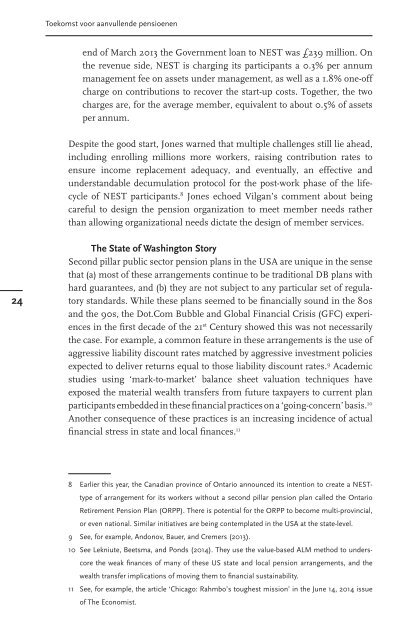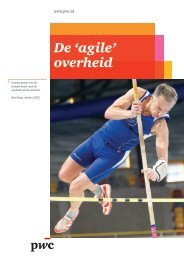Toekomst voor aanvullende pensioenen
Toekomst voor aanvullende pensioenen
Toekomst voor aanvullende pensioenen
- No tags were found...
Create successful ePaper yourself
Turn your PDF publications into a flip-book with our unique Google optimized e-Paper software.
<strong>Toekomst</strong> <strong>voor</strong> <strong>aanvullende</strong> <strong>pensioenen</strong>end of March 2013 the Government loan to NEST was £239 million. Onthe revenue side, NEST is charging its participants a 0.3% per annummanagement fee on assets under management, as well as a 1.8% one-offcharge on contributions to recover the start-up costs. Together, the twocharges are, for the average member, equivalent to about 0.5% of assetsper annum.Despite the good start, Jones warned that multiple challenges still lie ahead,including enrolling millions more workers, raising contribution rates toensure income replacement adequacy, and eventually, an effective andunderstandable decumulation protocol for the post-work phase of the lifecycleof NEST participants. 8 Jones echoed Vilgan’s comment about beingcareful to design the pension organization to meet member needs ratherthan allowing organizational needs dictate the design of member services.24The State of Washington StorySecond pillar public sector pension plans in the USA are unique in the sensethat (a) most of these arrangements continue to be traditional DB plans withhard guarantees, and (b) they are not subject to any particular set of regulatorystandards. While these plans seemed to be financially sound in the 80sand the 90s, the Dot.Com Bubble and Global Financial Crisis (GFC) experiencesin the first decade of the 21 st Century showed this was not necessarilythe case. For example, a common feature in these arrangements is the use ofaggressive liability discount rates matched by aggressive investment policiesexpected to deliver returns equal to those liability discount rates. 9 Academicstudies using ‘mark-to-market’ balance sheet valuation techniques haveexposed the material wealth transfers from future taxpayers to current planparticipants embedded in these financial practices on a ‘going-concern’ basis. 10Another consequence of these practices is an increasing incidence of actualfinancial stress in state and local finances. 118 Earlier this year, the Canadian province of Ontario announced its intention to create a NESTtypeof arrangement for its workers without a second pillar pension plan called the OntarioRetirement Pension Plan (ORPP). There is potential for the ORPP to become multi-provincial,or even national. Similar initiatives are being contemplated in the USA at the state-level.9 See, for example, Andonov, Bauer, and Cremers (2013).10 See Lekniute, Beetsma, and Ponds (2014). They use the value-based ALM method to underscorethe weak finances of many of these US state and local pension arrangements, and thewealth transfer implications of moving them to financial sustainability.11 See, for example, the article ‘Chicago: Rahmbo’s toughest mission’ in the June 14, 2014 issueof The Economist.




![Proefschrift Hanneke A. Luth[lr]](https://img.yumpu.com/51055008/1/178x260/proefschrift-hanneke-a-luthlr.jpg?quality=85)

![Proefschrift Hanneke A. Luth[lr]](https://img.yumpu.com/24018368/1/178x260/proefschrift-hanneke-a-luthlr.jpg?quality=85)